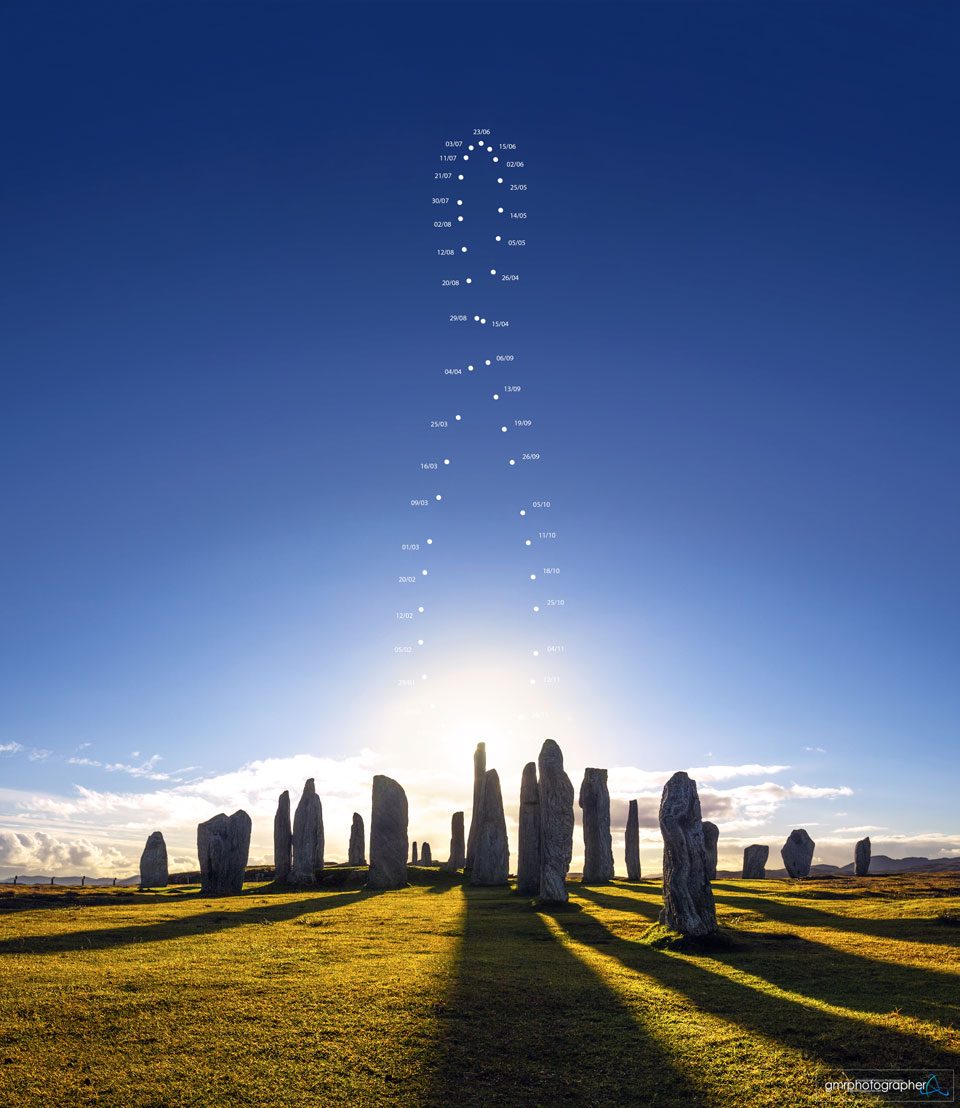18. September 2022
Callanish 岩石陣天頂 ê 日行軌跡

探索宇宙1!逐工會揀一幅無仝款 ê 影像抑是相片,𤆬你熟似咱這个迷人 ê 宇宙,閣有專業天文學者2為你3解說4。
- 原始文章:Analemma over the Callanish Stones
- 影像來源 kah 版權:Giuseppe Petricca
- 探索你的宇宙:APOD 亂數生產器
- 台文翻譯:An-Li Tsai (NCU)
[漢羅] Callanish 岩石陣天頂 ê 日行軌跡
你若是逐工仝一个時間 tī 外口仝一个所在 kā 太陽翕一張相,毋知太陽 tī 天頂 ê 位置會無仝無? 欲回答這个問題,上緊 ê 方式是看 日行軌跡,就是 tī 一冬內仝一个所在仝一个時間翕--ê 合成相片。 這張日行軌跡 是 tī 英國 蘇格蘭 Outer Hebrides 群島 Callanish 庄附近,kā 每幾若工就 tī 中晝翕--ê 相片合成--ê。 前景是 Callanish 岩石陣,是 西元前 2700 ê 一組岩石箍仔,彼陣猶是人類 ê 青銅時代。 咱毋知影這陣 Callanish 岩石陣 按呢排,是毋是有啥物天文意義。 日行軌跡會生做這个 8 字形,是因為 地球自轉軸趨一个角度,而且地球踅 太陽 ê 軌道 是 長株圓--ê。 到 冬夏至點 ê 時陣,太陽會出現 tī 日行軌跡上懸點抑是上低點。 這張相片是冬至彼陣翕--ê,所以太陽會出現 tī 上低點。 到 春秋分點 ê 時陣,太陽會出現 tī 日行軌跡 ê 中央點,毋閣毋是 tī 交叉點。 這禮拜五 世界時 半暝 1:04(美洲 是拜四)是 秋分點,這工 ê 日時 kah 暗時平長。 Tī 足濟文化內底會 tī 春秋分點 這工 慶祝 換季。
[POJ] Callanish giâm-chio̍h-tīn thiⁿ-téng ê Ji̍t-hêng kúi-jiah
Lí nā-sī ta̍k-kang kāng chi̍t-ê sî-kan tī gōa-kháu kāng chi̍t-ê só͘-chāi kā Thài-iông hip chi̍t-tiuⁿ siòng, m̄-chai Thài-iông tī thiⁿ-téng ê ūi-tì ē bô-kâng bô? Beh hôe-tap chit-ê būn-tê, siōng kín ê hong-sek sī khòaⁿ ji̍t-hêng-kúi-jiah, to̍h sī tī chi̍t tang lāi kāng chi̍t-ê só͘-chāi kāng chi̍t-ê sî-kan hip--ê ha̍p-sêng siòng-phìⁿ. Chit-tiuⁿ ji̍t-hêng-kúi-jiah sī tī Eng-kok So͘-keh-lân Outer Hebrides kûn-tó Callanish chng hū-kīn, kā múi kúi-ā kang to̍h tī tiong-tàu hip--ê siòng-phìⁿ ha̍p-sêng--ê. Chiân-kéng sī Callanish giâm-chio̍h-tīn, sī se-goân chêng 2700 ê chi̍t-cho͘ giâm-chio̍h kho͘-á, hit-chūn iáu-sī jîn-lūi ê Chhiⁿ-tâng sî-tāi. Lán m̄-chai-iáⁿ chit-tīn Callanish giâm-chio̍h-tīn án-ni pâi, sī-m̄-sī ū siáⁿ-mih thian-bûn ì-gī. Ji̍t-hêng-kúi-jiah ē seⁿ-chò chi̍t-ê 8 jī-hêng, sī in-ūi Tē-kiû chū-choán-te̍k chhu chi̍t-ê kak-tō͘, jī-chhiah Tē-kiû se̍h Thài-iông ê kúi-tō sī tn̂g-tu-îⁿ--ê. Kàu tang-hā chì-tiám chit-kang, Thài-iông ē chhut-hiān tī ji̍t-hêng-kúi-jiah siōng koân tiám iah-sī siōng kē tiám. Chit-tiuⁿ siòng-phìⁿ sī tang-chì hit-chūn hip--ê, só͘-í Thài-iông ē chhut-hiān tī siōng kē tiám. Kàu chhun-chhiu hun-tiám chit-kang, Thài-iông ē chhut-hiān tī ji̍t-hêng-kúi-jiah ê tiong-ng-tiám, m̄-koh m̄-sī tī kau-chhe-tiám. Chit lé-pài gō͘ Sè-kài-sî pòaⁿ-mî 1:04 (Bí-chiu sī pài-sì) sī chhiu-hun tiám, chit-kang ê ji̍t-si̍t kah àm-sî pêⁿ-tn̂g. Tī chiok chōe bûn-hòa lāi-té ē tī chhun-chhiu-hun chit-kang khèng-chiok ōaⁿ-kùi.
[KIP] Callanish giâm-tsio̍h-tīn thinn-tíng ê Ji̍t-hîng kuí-jiah
Lí nā-sī ta̍k-kang kāng tsi̍t-ê sî-kan tī guā-kháu kāng tsi̍t-ê sóo-tsāi kā Thài-iông hip tsi̍t-tiunn siòng, m̄-tsai Thài-iông tī thinn-tíng ê uī-tì ē bô-kâng bô? Beh huê-tap tsit-ê būn-tê, siōng kín ê hong-sik sī khuànn ji̍t-hîng-kuí-jiah, to̍h sī tī tsi̍t tang lāi kāng tsi̍t-ê sóo-tsāi kāng tsi̍t-ê sî-kan hip--ê ha̍p-sîng siòng-phìnn. Tsit-tiunn ji̍t-hîng-kuí-jiah sī tī Ing-kok Soo-keh-lân Outer Hebrides kûn-tó Callanish tsng hū-kīn, kā muí kuí-ā kang to̍h tī tiong-tàu hip--ê siòng-phìnn ha̍p-sîng--ê. Tsiân-kíng sī Callanish giâm-tsio̍h-tīn, sī se-guân tsîng 2700 ê tsi̍t-tsoo giâm-tsio̍h khoo-á, hit-tsūn iáu-sī jîn-luī ê Tshinn-tâng sî-tāi. Lán m̄-tsai-iánn tsit-tīn Callanish giâm-tsio̍h-tīn án-ni pâi, sī-m̄-sī ū siánn-mih thian-bûn ì-gī. Ji̍t-hîng-kuí-jiah ē senn-tsò tsi̍t-ê 8 jī-hîng, sī in-uī Tē-kiû tsū-tsuán-ti̍k tshu tsi̍t-ê kak-tōo, jī-tshiah Tē-kiû se̍h Thài-iông ê kuí-tō sī tn̂g-tu-înn--ê. Kàu tang-hā tsì-tiám tsit-kang, Thài-iông ē tshut-hiān tī ji̍t-hîng-kuí-jiah siōng kuân tiám iah-sī siōng kē tiám. Tsit-tiunn siòng-phìnn sī tang-tsì hit-tsūn hip--ê, sóo-í Thài-iông ē tshut-hiān tī siōng kē tiám. Kàu tshun-tshiu hun-tiám tsit-kang, Thài-iông ē tshut-hiān tī ji̍t-hîng-kuí-jiah ê tiong-ng-tiám, m̄-koh m̄-sī tī kau-tshe-tiám. Tsit lé-pài gōo Sè-kài-sî puànn-mî 1:04 (Bí-tsiu sī pài-sì) sī tshiu-hun tiám, tsit-kang ê ji̍t-si̍t kah àm-sî pênn-tn̂g. Tī tsiok tsuē bûn-huà lāi-té ē tī tshun-tshiu-hun tsit-kang khìng-tsiok uānn-kuì.
[English] Analemma over the Callanish Stones
If you went outside at the same time every day and took a picture that included the Sun, how would the Sun's position change? A more visual answer to that question is an analemma, a composite image taken from the same spot at the same time over the course of a year. The featured analemma was composed from images taken every few days at noon near the village of Callanish in the Outer Hebrides in Scotland, UK. In the foreground are the Callanish Stones, a stone circle built around 2700 BC during humanity's Bronze Age. It is not known if the placement of the Callanish Stones has or had astronomical significance. The ultimate causes for the figure-8 shape of this and all analemmas are the tilt of the Earth axis and the ellipticity of the Earth's orbit around the Sun. At the solstices, the Sun will appear at the top or bottom of an analemma. The featured image was taken near the December solstice and so the Sun appears near the bottom. Equinoxes, however, correspond to analemma middle points -- not the intersection point. This coming Friday at 1:04 am (UT) -- Thursday in the Americas -- is the equinox ("equal night"), when day and night are equal over all of planet Earth. Many cultures celebrate a change of season at an equinox.
詞彙學習
| 漢羅 | POJ | KIP | 華語 | English |
|---|---|---|---|---|
| 日行軌跡 | ji̍t-hêng-kúi-jiah | ji̍t-hîng-kuí-jiah | 日行跡 | Analemma |
| 春秋分點 | chhun-chhiu hun-tiám | tshun-tshiu hun-tiám | 春秋分點 | equinox |
| 冬夏至點 | tang-hā chì-tiám | tang-hā tsì-tiám | 冬夏至點 | solstice |
| 交叉點 | kau-chhe-tiám | kau-tshe-tiám | 交叉點 | intersection point |
| 換季 | ōaⁿ-kùi | uānn-kuì | 換季 | change season |
| 青銅時代 | Chhiⁿ-tâng sî-tāi | Tshinn-tâng sî-tāi | 青銅時代 | Bronze Age |
| 世界時 | Sè-kài-sî | Sè-kài-sî | 世界時 | Universal Time (UT) |